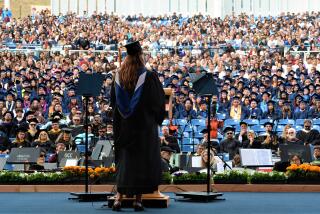Catching Waves--Via Satellite : Technology: Orange Coast College’s new weather oceanography system proves popular among students--from science majors to surfers.
- Share via
COSTA MESA — Hour upon hour, students hover around a TV-like screen at Orange Coast College here, avidly watching black-and-white images flash before them.
No, it isn’t a campus fad built around old movies or vintage television. The rage here is a recently acquired electronic system that taps American, Chinese and Russian weather satellites. Clusters of students--from science majors to surfers--hang out in Room 118 at the college’s Applied Science Building, watching satellite-transmitted scenes of North American weather.
“You’re always going to find a crowd around this equipment,” said Tom Garrison, chairman of Orange Coast’s Marine Science Department.
The college’s popular new electronic device is called a satellite weather oceanography system. Orange Coast obtained the system for about $1,500 in June. College officials say that only one other teaching institution in California--the Scripps Institution of Oceanography in La Jolla--has similar equipment for student use.
“We’ve wanted this for a long time, and the cost finally came down so that we could afford it,” Garrison said. “Students learn many things from using the system. Among other things, they learn about geography and weather.”
Surfers are among the fans of the new equipment.
“The other day we had several surfers in here, and we were able to predict big waves for the following day,” Garrison said.
“The next day, a surfer came back and told me, ‘Totally awesome, dude. Can you get us some more waves like that?”’
Garrison grinned as he recalled the incident. “I told the kid that we can’t make the waves but that he could come here and watch for weather conditions that would produce the big waves.”
The system taps into signals relayed to Earth by five weather satellites that orbit from the North Pole to the South Pole and back north again.
Students use a computer keyboard to project satellite images upon a TV-like screen. The images can be enlarged so that amazingly fine details can be seen with the naked eye.
On a recent morning, William Shea, 31, of Costa Mesa, a computer sciences major, was the student in charge of the computer keyboard for the system. He quickly punched a series of keys. The screen then glowed with an outline of the coast of California, as seen from an orbiting weather satellite.
“I plan to transfer from here to UC Santa Barbara, and my goal is to become a specialist in computer science, using it in connection with marine biology,” said Shea. He said the new satellite system is a great learning tool. “We’re learning a lot about California and other U.S. geography,” he said.
Terry Smith, 24, of Murrieta, a telecommunications major, was among students observing the equipment. “I hope some day to be in media productions, behind the scenes, and learning about this (satellite weather tracking) could help me in relating to the television weather people,” he said.
Added Scott Gnagy, 20, of Westminster, a marine science major: “I’m learning geography and weather patterns from this system. You track weather systems as they move. We recently tracked Hurricane Greg as it came up from the Baja area.”
Garrison said the Orange Coast system receives images from the satellites through an antenna atop the Applied Science Building. The computer equipment records and stores the images, so that students can call up pictures of weather systems several weeks old.
The use of the satellites costs the college nothing.
“There’s no charge,” said Garrison. “The satellites send images out, and we pick them up with our receiver. It’s the same principle as turning on your television to pick up the nightly news.”
More to Read
Sign up for Essential California
The most important California stories and recommendations in your inbox every morning.
You may occasionally receive promotional content from the Los Angeles Times.













